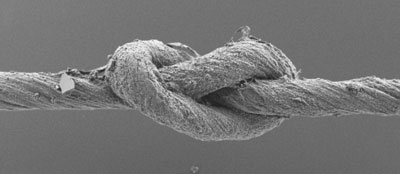Materials such as metals and semiconductors have been spun into yarns that can be woven, sewn and tied in knots, raising the possibility of new types of textiles with electronic capabilities.
Ray Baughman and his co-workers at the University of Texas at Dallas used a low concentration of multi-walled carbon nanotubes as the 'host' material to provide durable, flexible and weavable yarns. A high concentration of 'guest' material added the desired functionality. The researchers fabricated 100-micrometre-wide yarns by twist-spinning specific combinations of the two components, a method that overcomes limitations, such as lack of material durability and functionality, of previous approaches.
Using lithium iron phosphate (LiFePO4) as the cathode (pictured) and graphene nanoribbon yarn as the anode, the authors describe how to create a weavable yarn with promising lithium-ion battery functionality.

SCIENCE/AAAS




